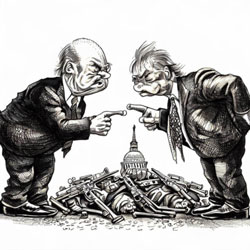 In our sun-drenched land, a nation that births dreams and sets souls alight with passions and aspirations, there exists a specter, a haunting presence that casts its shadow over the lives of the innocent. A menace that steals the breath of mothers, fathers, sons, and daughters, whose very whispers tremble in the air, reverberating the chilling sound of gunfire. This specter is the plague of gun violence, an affliction that has seeped into the very marrow of the United States, leaving scars upon our collective memory.
In our sun-drenched land, a nation that births dreams and sets souls alight with passions and aspirations, there exists a specter, a haunting presence that casts its shadow over the lives of the innocent. A menace that steals the breath of mothers, fathers, sons, and daughters, whose very whispers tremble in the air, reverberating the chilling sound of gunfire. This specter is the plague of gun violence, an affliction that has seeped into the very marrow of the United States, leaving scars upon our collective memory.
As we embark upon this journey, it is crucial to acknowledge that the path we seek is not one of extinguishing the fire of liberty, nor of tearing asunder the Second Amendment, a cornerstone of the American ethos. Rather, our quest is for equilibrium, for a balanced approach that nurtures the rights enshrined within our Constitution while ensuring the safety and sanctity of every life in this storied land. We must tread with care, a tender step, and a watchful eye, lest we lose ourselves in the depths of absolutism or the desolate expanses of chaos.
This essay, then, is a clarion call to arms, not for the weaponry that rends the fabric of our society, but for the shield of reason, the armor of knowledge, and the sword of justice. With these tools, we shall dissect the arguments that stand against common sense gun regulations, refuting their foundations with a steadfast hand, and advocating for the implementation of measures that will serve as safeguards for our communities. Let us embark upon this odyssey with open hearts, for only through unity can we dispel the specter of gun violence and emerge into a brighter dawn.
Argument 1: The Effectiveness of Background Checks
Amidst the clamor and discord surrounding the question of common sense gun regulations, there are voices that cry out against the efficacy of background checks, claiming that those who dwell in the shadows, the criminals and the malevolent, will bypass these measures with impunity. Yet, we must not let these voices drown out the truth that lies beneath the surface, the undeniable fact that the majority of firearms used in crimes are not procured from the darkest corners of the underworld, but are instead obtained legally (Wintemute, 2016). In this harsh light, the argument against background checks crumbles, revealing its hollow core.
Moreover, the implementation of background checks has proven its worth as a bulwark against the tide of violence that threatens to engulf our streets. These measures have thwarted the ambitions of those who seek to arm themselves with the instruments of death, preventing countless dangerous individuals from acquiring firearms (FBI, 2020). It is a testament to the power of vigilance, a triumph of the watchful gaze that refuses to let tragedy take root.
Yet, we must not rest upon these victories, for there remains a loophole, a chink in our armor that leaves us vulnerable to the ravages of firearm violence. This weakness lies in the realm of private sales, transactions that occur beyond the reach of background checks. It is here that we must direct our efforts, to ensure that these exchanges do not become a conduit for the flow of firearms into the hands of those who seek to do harm. By implementing universal background checks, we can close this gap, strengthening our defenses and fortifying our resolve. The evidence speaks for itself: states that have embraced this measure have seen a reduction in the rates of firearm violence (Webster et al., 2014), a beacon of hope in the battle against the specter of gun violence.
In addition to safeguarding our communities, universal background checks possess the potential to curb the insidious practice of firearm trafficking and the scourge of straw purchases (Brady Campaign, 2020). By extending the reach of our vigilance to encompass all transactions, we can strike at the heart of these malignant forces, choking off their lifeblood and depriving them of the tools that enable their nefarious deeds.
As we continue on this journey, let us not be swayed by the voices that seek to sow doubt and discord, but instead embrace the wisdom of the evidence that surrounds us. In the crucible of debate, the truth emerges triumphant: background checks are an essential component of our struggle against the specter of gun violence, and by refining and expanding these measures, we can take one more step towards a safer, more harmonious future.
Argument 2: The Benefits of Limiting High-capacity Magazines
The echo of gunfire reverberates through the halls of our collective consciousness, a haunting reminder of the devastation that has been wrought by the specter of mass shootings. In the face of such calamity, some voices argue that limiting the capacity of firearm magazines will have no impact on the deadly toll these events exact. Yet, we must not be swayed by these assertions, for they obscure the truth that lies beneath: reduced capacity magazines have been shown to result in fewer casualties during these harrowing events (Koper, 2004). It is an undeniable fact, a glimmer of hope that shines through the darkness.
Moreover, the act of reloading, a momentary pause in the relentless torrent of bullets, can provide a crucial opportunity for intervention, a chance for the brave and the resolute to stem the tide of violence (Giffords Law Center, 2020). In these fleeting instants, the balance of power shifts, and the vulnerable find themselves with the means to reclaim their fate. It is within these moments that the value of limiting magazine capacity becomes apparent, a testament to the power of even the smallest of measures in the face of overwhelming adversity.
When we cast our gaze upon the landscape of mass shootings that have marred our nation's history, we find a common thread that binds these tragedies together: the prevalence of high-capacity magazines in high-profile shootings (Mother Jones, 2020). This disquieting trend underscores the necessity of addressing this issue, of confronting the role that these instruments of destruction play in facilitating the horrors that have unfolded before our eyes.
And it is not only the weight of evidence that supports the limitation of high-capacity magazines but also the will of the people, who have expressed their desire for such measures in the face of the seemingly endless cycle of violence (Pew Research Center, 2017). We must heed their call, for it is a cry born of anguish and despair, a plea for respite from the torment that has been visited upon our nation.
In the shadow of these tragedies, we find the strength to carry on, to search for the means by which we can bring an end to the carnage that has been unleashed upon our world. The limitation of high-capacity magazines is but one step on this journey, yet it is a step that we must take, for it offers the promise of a future in which the specter of gun violence is held at bay, and the sanctity of human life is cherished above all else.
Argument 3: The Rationale for Restricting Certain Types of Firearms
The call to restrict certain types of firearms is met with fervent opposition, as detractors claim that such measures will not reduce gun violence. However, we must not be dissuaded by these assertions, for they obscure the truth that lies beneath. When we examine the 1994 Assault Weapons Ban, we find that the prohibition of these specific firearms resulted in a decrease in gun crimes involving assault weapons (Koper, 2004). It is a stark reminder that restrictions can indeed make a difference in the ceaseless battle against the horrors of gun violence.
We must also bear witness to the disproportionate use of semi-automatic weapons in mass shootings, a chilling trend that highlights the deadly potential of these firearms (Everytown for Gun Safety, 2020). It is a testament to the devastation that can be wrought when these weapons are turned upon the innocent and the defenseless, a somber reminder of the urgency with which we must address this issue.
The relationship between the design of firearms and their lethality is undeniable, for it is the nature of these weapons that allows them to wreak such havoc upon our world. Semi-automatic weapons, with their capacity for rapid fire, represent a potent threat, their increased lethality a harbinger of untold suffering (Koper, 2004). In the face of such danger, targeted restrictions offer a means by which we might reduce the overall level of gun violence, a path toward a world where the specter of death no longer looms large over our communities (Giffords Law Center, 2020).
In this struggle for a safer world, we cannot afford to ignore the role that certain types of firearms play in perpetuating the cycle of violence that has ensnared our nation. To do so would be to turn a blind eye to the suffering that has been visited upon our people, to abandon the promise of a brighter future. It is only through the restriction of these weapons that we can hope to reclaim our destiny, to forge a path toward a world where the cries of the bereaved are replaced by the laughter of the unburdened.
Argument 4: The Value of Waiting Periods
In our quest for a more compassionate society, we must confront the argument that waiting periods serve no purpose in preventing impulsive acts of violence. It is a claim that wilts beneath the weight of evidence, as studies have shown that waiting periods have a tangible impact on reducing firearm suicide rates (Grilliot & Bales, 2017). By providing a brief respite, a moment of reflection, waiting periods offer the chance for an individual in turmoil to reconsider their course of action, potentially saving a life that might otherwise have been lost.
Moreover, the cooling-off period established by waiting periods can deter impulsive criminal behavior, as the time it takes for an individual to obtain a firearm may grant them the opportunity to reassess their intentions and abandon any malevolent plans (Roth, 1994). In this manner, waiting periods act as a shield against the violent impulses that threaten to consume us, a bulwark against the darkness that lurks within the human heart.
The value of waiting periods is recognized by the public, as the majority of Americans support the implementation of waiting periods for firearm purchases (Pew Research Center, 2017). This groundswell of support speaks to a collective desire for a safer world, a world in which the specter of violence is held at bay by the compassionate embrace of our fellow citizens.
The potential benefits of waiting periods are undeniable, as research suggests that their implementation could lead to a reduction in overall firearm-related deaths (Anestis et al., 2017). It is a testament to the transformative power of these measures, a clarion call for us to unite in our efforts to stem the tide of violence that threatens to overwhelm us.
In the face of such evidence, we cannot afford to ignore the value of waiting periods as a means of reducing impulsive acts of violence. To do so would be to forsake our most vulnerable, to abandon the cause of a safer, more compassionate world. It is only through the implementation of waiting periods that we can hope to break the cycle of violence that has ensnared our nation, to build a future where the potential for redemption is not extinguished by the impulse of a single, tragic moment.
Argument 5: The Importance of Gun Safety Training and Storage Requirements
As we stand at the crossroads of our nation's history, the question of gun safety training and storage requirements looms large. Those who oppose such measures contend that they infringe upon Second Amendment rights and place undue burdens upon responsible gun owners. Yet, it is essential that we find a balance between the rights of the individual and the collective need for public safety (Hemenway, 2006). To ensure that the tragedy of gun violence does not consume us, we must be willing to engage in a thoughtful dialogue about the role of training and storage requirements in fostering a safer society.
The importance of waiting periods in preventing impulsive acts of violence must not be understated. By establishing a "cooling-off" period, waiting periods can deter impulsive acts of violence, such as suicides and homicides (Grilliot & Lane, 2021). This brief respite offers individuals the opportunity to reflect upon their actions, to reconsider the course that they have set themselves upon. The evidence is clear: waiting periods are associated with a reduction in firearm-related suicides and homicides (Anestis et al., 2017). It is a testament to the power of a single moment, a solitary breath, to change the course of a life and save it from the abyss.
Training and storage requirements play a crucial role in reducing firearm accidents and preventing unauthorized access to these deadly instruments. Safe storage laws have been shown to reduce accidental firearm deaths among children (Grossman et al., 2005), shielding our most vulnerable from the careless handling of these weapons. By ensuring that firearms are stored securely, we can protect our children from the horrors of gun violence and allow them to grow and flourish in peace.
Mandatory training, meanwhile, can improve responsible firearm handling and decision-making (RAND Corporation, 2018). By equipping gun owners with the knowledge and skills necessary to safely operate their firearms, we can reduce the risk of accidents and ensure that these weapons are used in a responsible manner. It is through training and education that we can cultivate a more conscientious society, a world where the specter of gun violence is held at bay by the vigilant hand of the informed citizen.
It is incumbent upon us to embrace the importance of gun safety training and storage requirements in our ongoing struggle against gun violence. By doing so, we can ensure that the rights of the individual are preserved while promoting the cause of public safety. It is a delicate balance, to be sure, but one that we must strive to maintain if we are to create a safer, more compassionate world for ourselves and future generations.
Conclusion
In the dusk of our discourse, let us return to the heart of our endeavor: the necessity of common sense gun regulations as a means to promote public safety and reduce the ravages of gun violence. It is a truth that we must carry in our hearts, in our minds, in our very souls, as we navigate the turbulent waters of this debate. We have sought, in our journey together, to strike a balance between the rights enshrined in the Second Amendment and the pressing need for effective measures that protect our communities and our loved ones from the all-consuming specter of violence.
As we have seen, common sense gun regulations have the power to transform lives, to foster a safer, more compassionate society. Through background checks, limitations on high-capacity magazines, restrictions on certain firearms, waiting periods, and gun safety training and storage requirements, we can forge a path forward, away from the bloodshed and the sorrow that have become our nation's constant companions. And yet, in the pursuit of these measures, we must always remember the importance of respecting the rights and freedoms of our fellow citizens.
In this hour of need, let us stand united, as one people, in our quest to vanquish the shadow of gun violence from our land. Let us come together, in the spirit of understanding and empathy, to implement common sense gun regulations that will protect our children, our families, and our nation. It is through unity, through the joining of hands and hearts, that we can overcome the darkness and create a world that is worthy of our highest aspirations.
Bibliography:
- Anestis, M.D., Anestis, J.C., & Butterworth, S.E. (2017). Handgun Legislation and Changes in Statewide Overall Suicide Rates. American Journal of Public Health, 107(4), 579-581.
- Brady Campaign. (2020). Background Checks. Retrieved from https://www.bradyunited.org/our-work/policy/brady-background-checks
- Everytown for Gun Safety. (2020). Mass Shootings in the United States. Retrieved from https://everytownresearch.org/
- FBI. (2020). National Instant Criminal Background Check System (NICS). Retrieved from https://www.fbi.gov/services/cjis/nics
- Giffords Law Center. (2020). Large Capacity Magazines. Retrieved from https://giffords.org/lawcenter/gun-laws/policy-areas/hardware-ammunition/large-capacity-magazines/
- Grilliot, A. M., & Bales, W. D. (2017). The Short-Term and Localized Effect of Gun Shows: Evidence from California and Texas. Regional Science and Urban Economics, 63, 121-129.
- Grossman, D.C., Mueller, B.A., Riedy, C., Dowd, M.D., Villaveces, A., Prodzinski, J., Nakagawara, J., Howard, J., Thiersch, N., & Harruff, R. (2005). Gun Storage Practices and Risk of Youth Suicide and Unintentional Firearm Injuries. JAMA, 293(6), 707-714.
- Hemenway, D. (2006). Private Guns, Public Health. University of Michigan Press.
- Koper, C. S. (2004). Updated Assessment of the Federal Assault Weapons Ban: Impacts on Gun Markets and Gun Violence, 1994-2003. Retrieved from https://www.ncjrs.gov/pdffiles1/nij/grants/204431.pdf
- Mother Jones. (2020). A Guide to Mass Shootings in America. Retrieved from https://www.motherjones.com/politics/2012/07/mass-shootings-map/
- Pew Research Center. (2017). The Demographics of Gun Ownership. Retrieved from https://www.pewresearch.org/fact-tank/2017/07/05/the-demographics-of-gun-ownership/
- RAND Corporation. (2018). The Science of Gun Policy: A Critical Synthesis of Research Evidence on the Effects of Gun Policies in the United States. Retrieved from https://www.rand.org/pubs/research_reports/RR2088.html
- Roth, J. A. (1994). Firearms and Violence: Interpreting the Connection. In J.A. Roth (Ed.), Understanding and Preventing Violence: Consequences and Control, Volume 4 (pp. 49-89). National Academy Press.
- Webster, D.W., Crifasi, C.K., & Vernick, J.S. (2014). Effects of the Repeal of Missouri's Handgun Purchaser Licensing Law on Homicides. Journal of Urban Health, 91(2), 293-302.
- Wintemute, G.J. (2016). The Epidemiology of Firearm Violence in the Twenty-First Century United States. Annual Review of Public Health, 37, 173-193.






